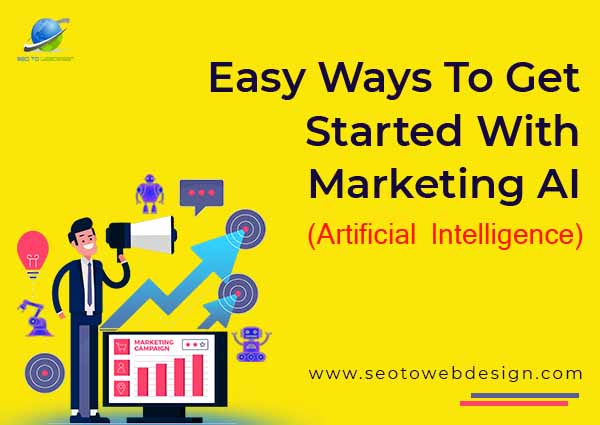Easy Ways to Get Started With Marketing AI (Artificial Intelligence)
In the following we will be discussing an important topic that is “8 Easy Ways to Get Started with Marketing AI (Artificial Intelligence)” and can discuss it in detail within the article:
Implementing an AI strategy is becoming a standard for brands, online retailers as well as agencies. According to eMarketer, 70% of business leaders expect marketing AI to be critical for the future success of their businesses. AI brings data-rich insights and time-saving assistance to marketers, and those who aren’t already using it need to embrace it now.
Choosing the right capabilities for your team might seem confusing, so here are some ways to get started quickly and easily. Whether you’re a specialized and technically savvy marketer, a jack-of-all-trades at a small business or someone who has been tasked with finding the perfect AI solution for your company, these 10 steps will help you think critically and make the best choice.
Understand What Marketing AI Really Is
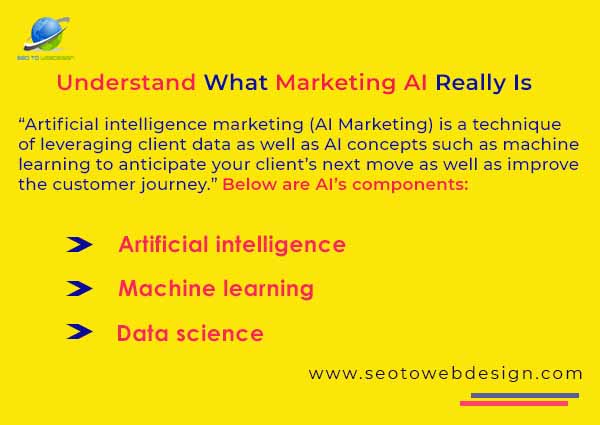
First, a quick definition:
“Artificial intelligence marketing (AI Marketing) is a technique of leveraging client data as well as AI concepts such as machine learning to anticipate your client’s next move as well as improve the customer journey.”
Before businesses can start implementing marketing AI solutions, it’s best to understand AI’s parts and pieces, and how they make work faster, easier and smarter. Below are explanations of AI’s components:
- Artificial Intelligence is a collection of machines that respond to stimulation in ways similar to how a human would. It can make decisions that normally require a human level of expertise.
- Machine Learning is a technology that analyzes vast amounts of data in order to discover trends and glean insights. It provides AI systems with the ability to automatically learn and improve.
- Data Science is the study of where the information originates, what it means and how it can be interpreted.
Generally, all three of these technologies go hand-in-hand. They give marketers the ability to understand vast amounts of data to inform their creative and strategic decision making.
See What Your Competitors Are Doing
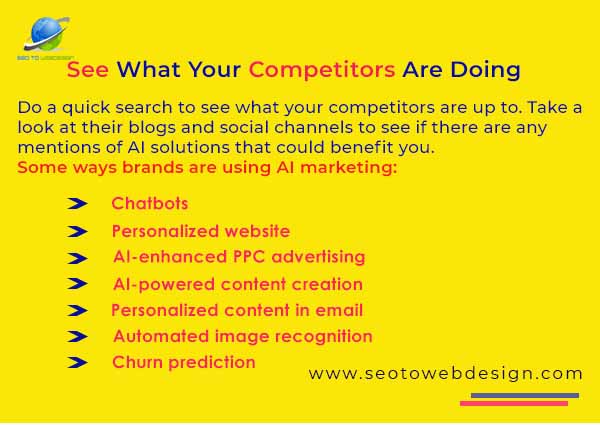
Do a quick search to see what your competitors are up to. You may be able to find out what solutions they’re already using, and how well those solutions are working for them. Take a look at their blogs and social channels to see if there are any mentions of AI solutions that could benefit you.
Some ways brands are using AI marketing:
- Chatbots
- AI-Enhanced PPC Advertising – AI-powered systems can help advertisers test out more ad platforms and optimize targeting.
- Personalized Website – By analyzing hundreds of data points about a single user, AI can display the best-fitting offers and content.
- AI-Powered Content Creation – From fashion to health to insurance, intelligent chatbots are providing borderline magic customer support.
- Personalized Content In Email – Algorithms can map a subscriber’s website experience and email browsing data to understand all the individual’s interactions with your content and create one-on-one personalized emails.
- Churn Prediction – Machine-learning algorithms can help identify disengaged customer segments that are about to churn or leave for a competitor.
- Automated Image Recognition – Amazon, Facebook, and Pinterest use AI-powered image recognition to identify people and objects from images and videos.
By knowing how your competitors’ solutions are working out for them, you’ll have an edge on what to look out for and how to catch up.
Define What You Expect from Your Marketing AI
Think beyond the buzzword and meditate on where you’re marketing is actually struggling the most. Identify what areas of your business will benefit highly from data analysis and AI’s insights, and visualize the performance you’d like to see. When you determine what you need AI to do, you will be able to narrow down the search field.
For example, if you want to improve creative performance for digital ads, research AI solutions that will help your team identify top-performing creative, so you can maximize results.
- Smartly.io is one such tool that allows you to create ads in different formats. The cloud-based automation tool cuts down the manual effort in running and editing paid campaigns and guides, marketers, to test and improve campaigns.
Alternatively, if you’re looking to discover more about your customers, look for an AI solution that will analyze their data and provide behavioral insights to you.
- Xinoah is an AI-driven tool that provides product and media recommenders, pricing solutions and demand predictors. It predicts customer behavior to help businesses provide better customer experience.
Understand Your Solution’s Data
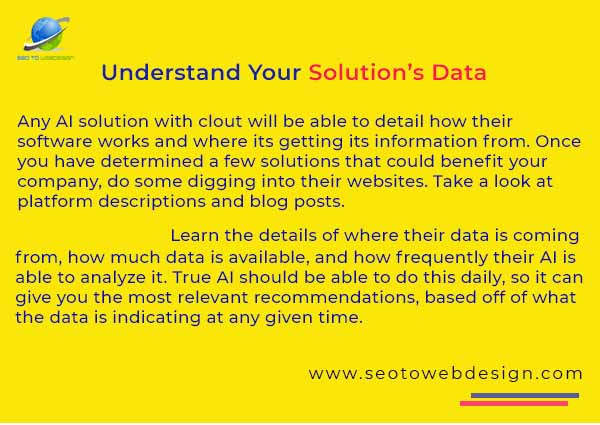
Any AI solution with clout will be able to detail how their software works and where it is getting its information from. Once you have determined a few solutions that could benefit your company, do some digging into their websites.
Take a look at platform descriptions and blog posts. AI companies who have true, efficient artificial intelligence solutions will describe how it works so that you know it’s not just a bunch of people in an office pretending to be AI.
Learn the details of where their data is coming from, how much data is available, and how frequently their AI is able to analyze it. True AI should be able to do this daily, so it can give you the most relevant recommendations, based on what the data is indicating at any given time.
Research Case Studies
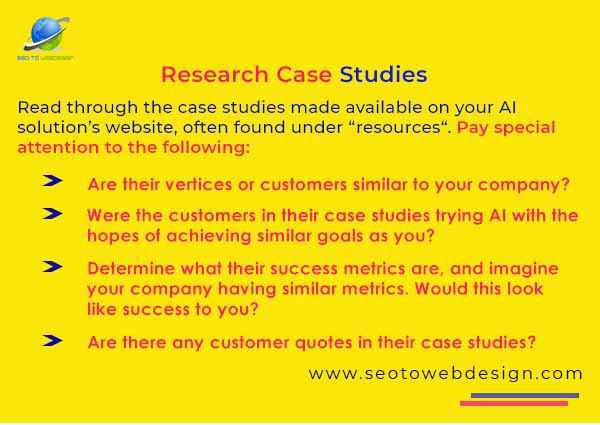
This point goes hand-in-hand with the previous one. Read through the case studies made available on your AI solution’s website, often found under “resources“.
Pay special attention to the following:
- Are their vertices or customers similar to your company?
- Were the customers in their case studies trying AI with the hopes of achieving similar goals as you?
- Determine what their success metrics are, and imagine your company having similar metrics. Would this look like success to you?
- Are there any customer quotes in their case studies? If so, what did they say and, specifically, what elements of the AI did they praise?
Ask if AI Solves Your Business Problems
Breakaway from the buzzword and think critically about what you really need. Just because everyone else is hopping onto the AI bandwagon doesn’t necessarily mean that your company needs to right now.
After you’ve established clear goals and done your research on solutions and competitors, you should start to get an idea of whether or not AI is right for you. Sometimes, it’s not – or not yet – and that’s ok. Don’t feel that you’ve wasted the effort doing the research that you have; it will come in handy when the perfect AI solution for your business is created.
Draft Your AI Ethics Statement
Ethics in AI is a hot topic these days, with publishers like The Wall Street Journal and Harvard Business Review discussing how to foster principled software development (one of the reasons is because of a tendency for racial and gender biases in AI hiring practices).
When you’re sure you’ve found the perfect marketing AI for your company, you’ll need to think about how to ensure that you use it ethically. When getting started with implementation, write out how AI will make your company better, due to its transparency and ethical approach to data analysis. If you publish your ethics statement for customers to read, it will build trust in your business and credibility in using cutting-edge technologies. If you decide to keep your ethics statement private, use it to hold yourself and your team accountable so that your work remains fair and transparent.
Here are a couple of examples of companies’ AI ethics statements:
- Phrasee
- Telia Company
Understand the Risks…And Opportunities!
With every marketing AI solution comes a few risks to consider:
- Your chosen solution may be expensive and you don’t yet have an AI budget. Some AI solutions pay for themselves because they offer cost-saving insights. Keep this in mind when shopping around.
- There may be a learning curve for your employees when using AI. Power through it! AI is new, and everyone who chooses to implement it has to learn, too. Everyone will be able to adapt here.
- People may feel threatened by AI and try to hold out on using it. The fear that AI will steal jobs is pretty wide-spread. Contrary to this popular belief, experts such as Forbes say that AI will take away menial tasks, not jobs. In fact, according to McKinsey, 77% of companies expect no change in their workforce when AI is implemented, and 17% expect the workforce to grow as a direct result of AI.
Along with these risks are loads of opportunities, such as:
- Understanding your customers better, and determining the best messages, mediums and creative opportunities for reaching them.
- Discovering the best ways to save money on marketing campaigns and advertisements by learning how to optimize ads and spend.
- Freeing up time on your calendar. Because many marketing AI solutions automate tasks, your team could save hours every week. This can give you more time to focus on creative and strategy work that would further benefit your business.
By thinking carefully through the risks of AI adoption and choosing the right solution for your brand, marketers will be able to find more opportunities than risks.


